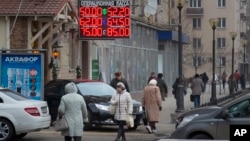The value of the Russian ruble plunged to new lows Monday against the dollar and euro, with Moscow's central bank predicting higher inflation and the national economy tumbling into a recession.
The ruble weakened by more than 5 percent, breaking through the level of 60 to the dollar and 75 to the euro for the first time. The Russian currency has dropped by 19 percent this month alone, and by more than 86 percent since last January, despite the central bank spending billions of dollars on market interventions in an attempt to curb its slide.
The ruble has diminished with the precipitous drop in the price of oil, the backbone of Russia's economy, and the effect of U.S. and European economic sanctions imposed against Russia because of President Vladimir Putin's intervention in Ukraine in support of pro-Russian rebels fighting Ukrainian forces.
The central bank said inflation could reach 11.5 percent in the first three months of 2015 before easing. At the same time, the bank says that the Russian economy is likely to contract next year.
The World Bank predicted last week that if the price of oil averages $78 a barrel next year, the Russian economy would drop seven-tenths of a percent.
But a steeper economic decline is certainly possible, since oil is now hovering around $60 a barrel and has been falling since the middle of the year. If oil prices stay at the $60 level, the central bank said the Russian economy could contract by as much as 4.8 percent next year.













